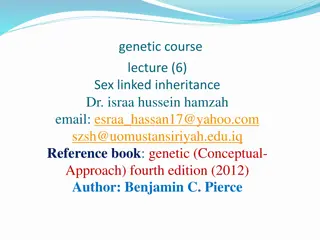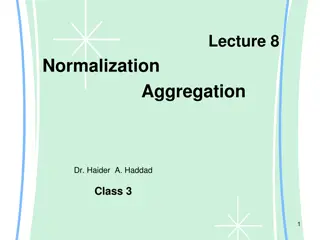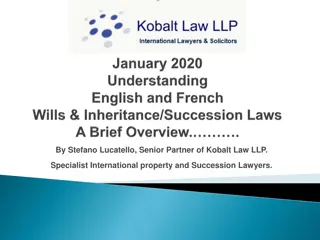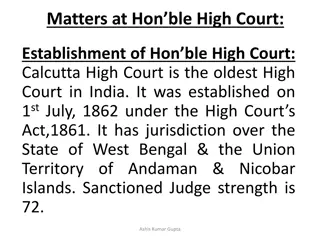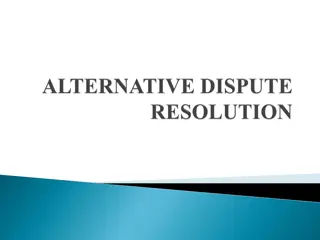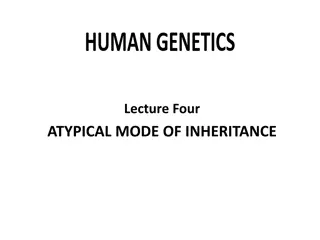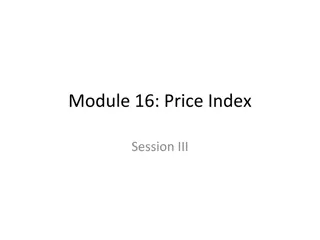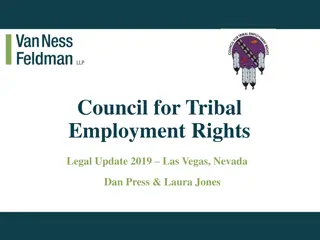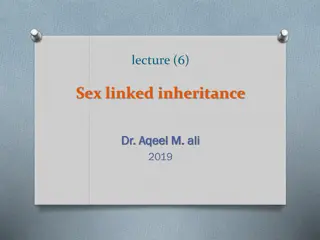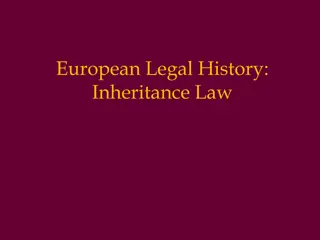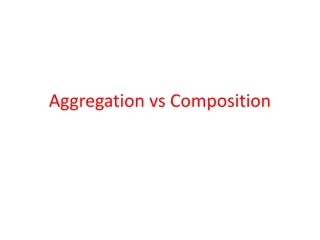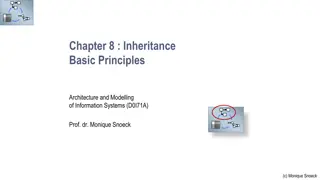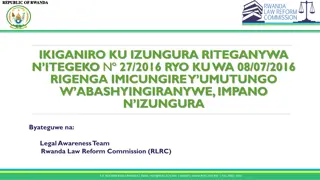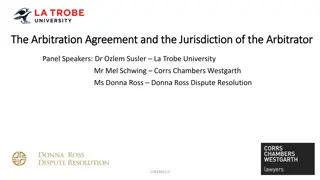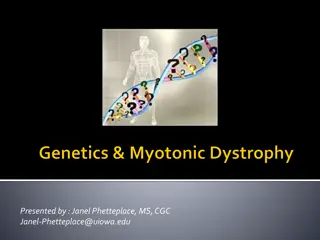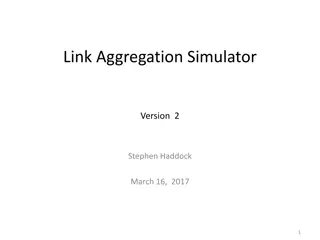Legal Jurisdiction and Aggregation Concerning Inheritance Dispute
Exploring jurisdictional amounts in legal disputes, the aggregation of claims, and complexities arising from inheritance distribution. Two distributees file an action against the estate's executor for misappropriation.
Download Presentation

Please find below an Image/Link to download the presentation.
The content on the website is provided AS IS for your information and personal use only. It may not be sold, licensed, or shared on other websites without obtaining consent from the author.If you encounter any issues during the download, it is possible that the publisher has removed the file from their server.
You are allowed to download the files provided on this website for personal or commercial use, subject to the condition that they are used lawfully. All files are the property of their respective owners.
The content on the website is provided AS IS for your information and personal use only. It may not be sold, licensed, or shared on other websites without obtaining consent from the author.
E N D
Presentation Transcript
St. Paul Mercury test It must appear to a legal certainty that the claim is really for less than the jurisdictional amount to justify dismissal.
1446(c)(2) If removal of a civil action is sought on the basis of the jurisdiction conferred by section 1332(a), the sum demanded in good faith in the initial pleading shall be deemed to be the amount in controversy, except that- (A) the notice of removal may assert the amount in controversy if the initial pleading seeks-- (i) nonmonetary relief; or (ii) a money judgment, but the State practice either does not permit demand for a specific sum or permits recovery of damages in excess of the amount demanded; and (B) removal of the action is proper on the basis of an amount in controversy asserted under subparagraph (A) if the district court finds, by the preponderance of the evidence, that the amount in controversy exceeds the amount specified in section 1332(a).
Can aggregate only an individual Ps actions against an individual D
exception to prohibition on aggregation concerning multiple parties common and undivided right
Someone has died. The two children of the decedent (P1 (NY) and P2 (NY)) are the distributees of his estate -- that is, they have a right to inherit. P1 and P2 bring an action against the executor of the estate (D (CA)), who, they allege, has absconded with $80,000. $40,000 of that should go to P1 and $40,000 to P2.
P1 and P2 are suing D. (P1 and P2 each have property adjoining D's.) P1 and P2 ask the court to enjoin D from polluting their property by shutting down his rendering plant. Assume that the cost to D in lost revenue if he shuts down the plant is $140,000. Is the amount in controversy satisfied for diversity?
PERSONAL JURISDICTION PERSONAL JURISDICTION IN STATE COURT IN STATE COURT
distinguish PJ from choice of law
- P and D are New Yorkers who get in a brawl in New York - D is in Oregon on business trip - P sues D in Oregon state court - D is served in Oregon with summons and complaint
distinguish PJ from subject matter jurisdiction
- P (NY) slips and falls in Ds (Germany) store in Germany - D has no connection with US - P sues D in in state court in NY asking for $100,000 - D is served in Germany with the summons and complaint
distinguish PJ from service/notice
- P and D are New Yorkers who get in a brawl in New York - P sues D in Oregon state court - D is served in New York with summons and complaint
- P and D are New Yorkers who get in a brawl in New York - P sues D in New York state court - P serves D by taking the summons and complaint and flushing it down the toilet
Mitchell v. Neff - Mitchell sues Neff for unpaid legal services in Oregon state court - Neff has moved to Cal. - the alleged source of PJ over Neff is his Oregon property - service was by a publication that had practically no circulation outside Oregon - Neff defaults - the Ore. state court attaches the land and sells it in payment of the debt to...Mitchell himself - Mitchell sells it to Pennoyer
Neff v. Pennoyer - Neff finds out, sues Pennoyer in ejectment in federal court in Ore. - diversity case - Pennoyer claims it is his, because it was Mitchell s, who got it pursuant to the enforcement of a valid Ore. state ct judgment - so Neff is collateral attacking the validity of the judgment in Mitchell v. Neff - was there PJ? - federal trial court says no - US SCt affirms (for different reasons)
1) dicta: the matter going forward will be governed by the 14thA. - but not in the present case, because the 14thA. had not been ratified when Mitchell v. Neff occurred - the question must be answered according to international law on the recognition of foreign judgments (as interpreted by federal courts) 2) there was no PJ, despite the fact that Neff had property in Oregon, because the property was not attached at the outset of the suit
distinguish PJ from forms of preliminary relief
- Mitchell sues Neff in state court in Oregon - the source of PJ is property Neff has in Oregon, identified at the initiation of the lawsuit - it does not look like Neff is at risk of selling is property to escape jurisdiction, so the court refrains from attaching the property
- the requirement of attachment for in rem was soon abandoned, provided that the property is identified at the outset
- P sues the D Corp. to prohibit its merger with the X Corp. - If the merger continues during the litigation, it will be practically impossible for the D and X Corps to be pulled apart again - P therefore asks for a preliminary injunction against the merger during the litigation
effect of limits on PJ being read into the 14thAmendment...
- P sues D in Oregon state court. - D has no connection with Oregon, but Oregon law allows the assertion of PJ over D. - D defaults. - P then sues on the default judgment in Oregon state court. Pre-Pennoyer: D has no grounds for challenging the judgment that could be entertained by the US SCt. Post-Pennoyer: D can challenge the judgment as a violation of the Due Process Clause of the 14thAmendment and appeal to the US SCt.
Amendment XIV. Section 1. . . . nor shall any State deprive any person of life, liberty, or property, without due process of law
in personam source of PJ is presence of D at initiation of suit (NOT at time of event being adjudicated) tagging
in rem source of PJ is presence of property at initiation of suit suit concerns ownership of property (e.g. quiet title action) binding upon all possible claimants
quasi in rem two types: 1) source of PJ is D s property in state at initiation of suit, but suit does not concern ownership of property although if P wins, D s property may be used to execute judgment
2) suit concerns ownership of property (e.g. quiet title action), BUT binding only on certain named parties
direct - motion to dismiss for lack of PJ - motion to set aside judgment indirect - collateral attack
- Assume that CA court that rendered a judgment had PJ - Why does a NY state court have to give it any respect?
- D, a US national residing in NY, is sued by P, an Iranian, in an Iranian court an Iranian court concerning a brawl that D got into with P in NY. - D is tagged while in Iran on a brief trip. - D defaults and a monetary judgment is issued against D. - P then sues upon the judgment in New York state court York state court. in New
- D, a citizen and resident of NY, is sued by P, a citizen and resident of CA, in California state court state court concerning a brawl that D got into with P in NY. - D is tagged while in CA on a brief trip. - D defaults and a monetary judgment is issued against D. - P then sues upon the judgment in state court in NY court in NY. in California state
Art IV, 1. Full Faith and Credit Full Faith and Credit shall be given in each State to the public Acts, Records, and judicial Proceedings judicial Proceedings of every other State And the Congress may by general Laws prescribe the Manner in which such Acts, Records and Proceedings shall be proved, and the Effect thereof. every other State.
- D, a citizen and resident of NY, is sued by P, a citizen and resident of CA, in California state court state court concerning a brawl that D got into with P in NY. - D is tagged while in CA on a brief trip. - D defaults and a monetary judgment is issued against D. - P then sues upon the judgment in federal court in NY court in NY. California in federal
28 U.S.C. 1738. - State and Territorial statutes and judicial proceedings; full faith and credit ... The records and judicial proceedings of any court of any judicial proceedings of any court of any such State, such State, Territory or Possession, or copies thereof, shall be proved or admitted in other courts within the United States and its Territories and Possessions by the attestation of the clerk and seal of the court annexed, if a seal exists, together with a certificate of a judge of the court that the said attestation is in proper form. Such Acts, records and judicial proceedings or copies thereof, so authenticated, shall have the same full faith shall have the same full faith and credit in every court within the United States and its and credit in every court within the United States and its Territories and Possessions as they have by law or usage in Territories and Possessions as they have by law or usage in the courts of such State, Territory or Possession from which the courts of such State, Territory or Possession from which they are taken. they are taken.
- D, a citizen and resident of NY, is sued by P, a citizen and resident of CA, in federal court in California court in California concerning a brawl that D got into with P in NY. - D is tagged while in CA on a brief trip. - D defaults and a monetary judgment is issued against D. - P then sues upon the judgment in state court in NY court in NY. federal state
Art. VI This Constitution, and the laws of the United States which shall be made in pursuance thereof; and all treaties made, or which shall be made, under the authority of the United States, shall be the supreme law of the land; and the judges in every state shall be bound thereby, anything in the Constitution or laws of any State to the contrary notwithstanding.
But no FF&C obligation if the judgment was invalid for lack of PJ
distinguish federal constitutional limits (under the 14thA.) on a state s assertion of PJ over a defendant - what a state can do what a state has chosen to do under its own law


